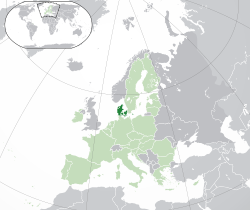
Denmark
Country in Northern Europe / From Wikipedia, the free encyclopedia
Dear Wikiwand AI, let's keep it short by simply answering these key questions:
Can you list the top facts and stats about Denmark?
Summarize this article for a 10 years old
Denmark (Danish: Danmark, pronounced [ˈtænmɑk] ⓘ) is a Nordic country in Northern Europe. It is the metropolitan part of and the most populous constituent of the Kingdom of Denmark,[N 9] a constitutionally unitary state that includes the autonomous territories of the Faroe Islands and Greenland in the North Atlantic Ocean.[15] Metropolitan Denmark[N 10] is the southernmost of the Scandinavian countries, lying south-west and south (Bornholm and Ertholmene) of Sweden, south of Norway,[N 11] and north of Germany, with which it shares a short border, Denmark's only land border.
Denmark | |
|---|---|
| Motto: | |
| Anthem: Der er et yndigt land (Danish) (English: "There is a magnificent country") | |
| National and royal anthem: Kong Christian stod ved højen mast (Danish)[N 2] (English: "King Christian stood by the lofty mast") | |
Location of metropolitan Denmark (dark green) | |
| Sovereign state | Kingdom of Denmark |
| Consolidation | c. 8th century[3] |
| Christianization | c. 965[4] |
| Constitutional Act | 5 June 1849 |
| Faroese home rule | 24 March 1948 |
| EEC accession | 1 January 1973 |
| Greenlandic home rule | 1 May 1979 |
| Capital and largest city | Copenhagen 55°43′N 12°34′E |
| Official languages | Danish |
| German[N 3] | |
| Ethnic groups (2020) | |
| Religion (2020) |
|
| Demonym(s) | |
| Government | Unitary parliamentary constitutional monarchy |
• Monarch | Margrethe II |
| Mette Frederiksen | |
| Søren Gade | |
| Legislature | Folketing |
| Area | |
• Total | 42,943[9] km2 (16,580 sq mi) (130th) |
• Water (%) | 1.74[10] |
| Highest elevation (Møllehøj) | 170.86 m (560.56 ft) |
| Population | |
• February 2023 estimate | |
• Density | 138.22/km2 (358.0/sq mi) |
| GDP (PPP) | 2022 estimate |
• Total | |
• Per capita | |
| GDP (nominal) | 2022 estimate |
• Total | |
• Per capita | |
| Gini (2021) | low |
| HDI (2021) | very high · 6th |
| Currency | Danish krone (kr.) (DKK)[N 7][citation needed] |
| Time zone | UTC+01:00 (CET) |
| UTC+02:00 (CEST) | |
| Date format | dd/mm/yyyy |
| Mains electricity | 230 V–50 Hz |
| Driving side | right |
| Calling code | +45 |
| ISO 3166 code | DK |
| Internet TLD | .dk[N 8] |
| Website | denmark |
As of 2013, the Kingdom of Denmark, including the Faroe Islands and Greenland, had a total of 1,419 islands above 100 square metres (1,100 sq ft); 443 of these have been named and 78 are inhabited.[16] Spanning a total area of 42,943 km2 (16,580 sq mi),[9] metropolitan Denmark consists of the northern part of the Jutland peninsula and an archipelago of 406 islands.[17] Of these, the most populated island is Zealand, on which the capital and largest city, Copenhagen, is situated, followed by Funen, the North Jutlandic Island, and Amager.[18] Denmark has flat, arable land, sandy coasts, low elevations, and a temperate climate. It had a population of 5.935 million (1 February 2023), of whom 800,000 live in Copenhagen (2 million in the wider area).[19] Denmark exercises hegemonic influence in the Danish Realm, devolving powers to handle internal affairs. Home rule was established in the Faroe Islands in 1948 and in Greenland in 1979; the latter obtained further autonomy in 2009.
The unified Kingdom of Denmark emerged in the 8th century AD as a proficient maritime power amid the struggle for control of the Baltic Sea.[3] In 1397, it joined Norway and Sweden to form the Kalmar Union, which persisted until the latter's secession in 1523. The remaining Kingdom of Denmark–Norway endured a series of wars in the 17th century that resulted in further territorial cessions. A surge of nationalist movements in the 19th century were defeated in the First Schleswig War of 1848. The adoption of the Constitution of Denmark on 5 June 1849 ended the absolute monarchy and introduced the current parliamentary system. An industrialised exporter of agricultural produce in the second half of the 19th century, Denmark introduced social and labour-market reforms in the early 20th century, which formed the basis for the present welfare state model and advanced mixed economy. Denmark remained neutral during World War I; Danish neutrality was violated in World War II by a swift German invasion in April 1940. During occupation, a resistance movement emerged in 1943, while Iceland declared independence in 1944; Denmark was liberated in May 1945. In 1973, Denmark, together with Greenland but not the Faroe Islands, became a member of what is now the European Union, but negotiated certain opt-outs, such as retaining its own currency, the krone.
Denmark is a developed country with a high standard of living. Denmark is a founding member of NATO, the Nordic Council, the OECD, the OSCE, and the United Nations; it is also part of the Schengen Area. Denmark maintains close political, cultural, and linguistic ties with its Scandinavian neighbours, with the Danish language being partially mutually intelligible with both Norwegian and Swedish.


.svg/250px-Denmark_(orthographic_projection).svg.png)
